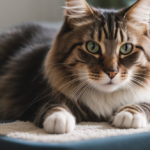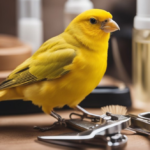Here is our list with The Most Common Cat Diseases A-Z. Just like humans, cats can also suffer from various diseases. Often the diseases are harmless, but in most cases they still require medical treatment. We give you a small overview of the most common cat diseases, their symptoms and causes.
Overview
A
Abscess
Symptoms:
Painful swelling. Common in cats, but not exclusively found in the head area. If it opens to the outside, pus empties from the abscess cavity.
Possible causes:
Injuries, especially bite injuries
Bacterial infections
Anemia
Symptoms:
Anemia, also known as anaemia, causes cats to lose appetite and drive. The tongue and gums are pale and the coat becomes dull and shaggy as the disease persists.
Possible causes:
Blood loss
poisonings
parasite infestation
kidney or liver disease
malnourishment
infectious diseases
Aortic Thrombosis
Symptoms:
Sudden severe pain. Paralysis of the hind legs, cold hind legs, disturbed sensitivity of the hind legs. In cats with pink pads, the rear pads of the feet are usually too bluish-lilac.
Possible causes:
Coagulation disorder
Blood clot at the branch of the aorta (main artery)
Arthrosis
Symptoms:
Cat lies more, becomes calmer. She often cleans less because of the pain and therefore gets a shaggy coat. Sometimes lameness occurs.
Possible causes:
Chronic joint inflammation due to sprains, malformations, signs of wear, or free cartilage particles (so-called joint mice) in the joint.
Save up to 30% on Your First Subscription in Pets
B
Bladder inflammation (cystitis)
Symptoms:
The cat urinates more than usual and thereby sheds small amounts of urine, which can also be brown-red in colour. She often goes to a soft ground for this. So if your cat suddenly pisses on a sofa cushion, it can also be due to a bladder infection when she is house-trained. Sometimes the urine heel is so painful that she complains.
Possible causes:
Bladder stones
urine semolina
infections
C
Cat Cold
Symptoms:
Sticky eyes and nose, sneezing, sometimes also increased breathing and fever. Cats suffering from cat cold are weak and without appetite.
Possible causes:
Infection by other sick cats. It is often not a single pathogen, but different viruses and bacteria are involved together in the emergence.
Cat Pox
Symptoms:
Changes occur in the skin in the form of nodes. These are found especially in the head area. In addition, the cat can suffer from inflammation of the mucous membranes of the mouth and tongue.
Possible causes:
Cowpox viruses transmitted by rodents such as rats or mice.
Cat Epidemic (also: panleukopenia)
Symptoms:
Severe diarrhea, high fever, apathy, unwillingness to eat. In addition, conjunctivitis and nasal discharge are possible due to the weakened immune system. The animals often die suddenly, sometimes without showing any symptoms at all.
Possible cause:
Infection with the panleukopenia virus. This is possible through contact with diseased cats, but also through contaminated objects.
Chronic renal insufficiency (CNI)
Symptoms:
In the early stages of the disease, the cat suffers from loss of appetite and severe thirst. More urine is urinated and leads to vomiting and weight loss. With advanced disease, ulcers can form. The mucous membrane of the mouth becomes inflamed and causes a strong and unpleasant odour. Blood pressure increases and bleeding and water retention can occur.
Possible causes:
Chronic kidney failure mainly affects older cats. The causes are manifold and must be investigated on a case-by-case basis.
Cornea Nigra
Symptoms:
A dark brown to black spot develops in the cat’s eye, usually centrally. Sometimes the eye is red and painful.
Possible causes:
Short-headed breeds, e.g. Persian cats, are more frequently affected. The cause is a cell death in the uppermost layer of the eye, the cornea. This is called corneal necrosis.
Corneal injury (corneal defect)
Symptoms:
Possible turbidity on the cornea (outer skin layer of the eye) of the affected eye. The cat closes the cornea more often, it runs and is reddened, sometimes swollen.
Possible causes:
In free roaming cats e.g. injury by knots or thorns. Also possible through rank fights. Can always occur if the eyelid cannot be closed quickly enough to protect the eye.
Prepare Pets and Pet Parents for Flea & Tick Season
D
Diabetes Mellitus
Symptoms:
Diseased cats drink more than usual and release larger amounts of urine. The appetite is enormously increased, nevertheless weight loss often occurs. The blood sugar level in the blood is permanently elevated.
Possible causes:
In cats most often overweight. This results in a relative insulin deficiency. (Diabetes mellitus type 2). Another cause would be an absolute insulin deficiency in diabetes mellitus type 1.
Diarrhoea
Symptoms:
The feces of the cat are liquid to watery, smelly and if necessary noticeably coloured. In addition, the anus of the cat may be inflamed.
Possible causes:
Parasite infestation
stress
allergies
infections
feed intolerances
E
Ear Mites
Symptoms:
Itchy, reddened ears. Often the ears look very dirty from the inside.
Possible cause:
Otodectes mites
Eclampsia
Symptoms:
Seizures and convulsions occur. The cat has weak legs, wheezing breathing and may lose consciousness.
Causes:
Calcium deficiency in nursing cats.
F
FIP (Feline Infectious Peritonitis)
Symptoms:
Fever, apathy, sometimes a thick stomach with simultaneous weight loss, lack of appetite. Can affect many different organs and lead to various symptoms. Occurs more frequently in young cats. Almost always fatal.
Possible causes:
The actually harmless Feline Coronavirus (FCoV), which can only develop into a dangerous virus in some cats and partly only after years.
FIV (Feline Immunodeficiency Virus)
Symptoms:
Very weak immune system. This causes many different symptoms, which can often be traced back to additional infections. These include diarrhoea, fever, apathy, gingivitis, conjunctivitis, unwillingness to eat and emaciation.
Possible causes:
Bite from an already infected cat
Transmission in the womb or by breast milk from cat to kitten possible
Flea infestation
Symptoms:
Only rarely do you see adult fleas jump. However, black crumbs can be brushed out of the cat’s coat with a flea comb. In case of severe infestation, they can also be seen when the coat is simply parted. If they are dissolved in water on a kitchen or handkerchief, they turn reddish. It concerns flea excrement.
Causes:
Infection by other infected animals or by objects (e.g. cushions or carpets) with flea larvae.
Idepet Catnip Toy for Cat, Catnip Ball Edible Kitty Toy Inte
G
Gastritis (inflammation of the gastric mucosa)
Symptoms:
Cats affected by gastritis often show reduced appetite. They often vomit their food or if they have not eaten for a long time.
possible cause:
Too long intervals between feedings
Food portions too large
stress
nervousness
metabolic problems
Giardiasis
Symptoms:
Diarrhoea, often alternating with normal stool. The faeces are slimy and smelly, sometimes bloody. Often cats are doing quite well, rarely they are knocked off.
Possible causes:
Single-celled parasites of the small intestine (Giardia). They spread through the absorption of contaminated water and contact with infected animals.
H
Hair loss
Symptoms:
The cat loses an excessive amount of hair and sometimes large bald spots appear on the body. Sometimes hair loss is accompanied by itching. By licking with their rough tongue, the cats then damage their own skin and cause redness and wounds.
Possible causes:
Parasite infestation
fungal diseases
allergies
stress, boredom, nervousness
fever, infections, deficiency symptoms
Hormone and metabolic disorders
Hyperthyroidism
Symptoms:
Great appetite. Sick cats want to eat all the time. Nevertheless, they lose weight. They often show aggressive behaviour and are hyperactive.
Possible causes:
Thyroid inflammations
autoimmune diseases
metabolic disorders
tumors
J
Jaundice (icterus)
Symptoms:
A cat affected by jaundice gets yellowish mucous membranes. The white eye skin and the skin surface itself also appear yellowish.
Possible causes:
Poisoning
inflammation of the liver
Damage to red blood cells
Problems of the bile ducts
L
Lungworms
Symptoms:
Only rarely does the cat show symptoms. Cough, nasal discharge and/or heavy breathing can only be detected in severe infections. In addition, the cat will also lose weight.
Possible cause:
Consumption of wild animals (mice, birds etc.)
P
Peritonitis (inflammation of the peritoneum)
Symptoms:
The affected cat is often without appetite and is knocked off. Depending on the type of inflammation, an upset stomach may appear. The excrement heel hurts. Possibly the cat has fever and shows apathy.
Possible causes:
Injury
Severe parasite infestation
Viral or bacterial infections (e.g. FIP = Feline Infectious Peritonitis)
Pleurisy
Symptoms:
The cat breathes very heavily, suffers from lack of appetite and drive. The symptoms only become noticeable when the disease has reached an advanced stage.
Possible causes:
Fluid in the chest cavity
infectious diseases
Poisoning
Symptoms:
Very different, depending on the type of toxin. Vomiting and diarrhoea are common. If the nervous system is affected, the cats can also stagger, cramp or show signs of paralysis. Coagulation disorders and associated bleeding are possible.
Possible causes:
Absorption of toxins (e.g. rat poison)
metabolic disorders
Eating poisonous houseplants or garden plants
Warmoor Cat Catnip Toys, Cat Toothbrush, Pet Interactive Che
R
Rabies
Symptoms:
At first a change of behaviour and character occurs. The cat withdraws, becomes disproportionately aggressive and suddenly makes sounds. Later, swallowing disorders occur, the cat salivates a lot and partly forms foam around the mouth.
Possible causes:
Infection with the rabies virus, e.g. by bites from infected foxes or bats.
S
Seizures
Symptoms:
During a seizure, the cat is usually unconscious for a few seconds to a few minutes. Depending on the intensity, the cat may stagger dizzily, twitch its legs uncontrollably and even develop foam in front of its mouth or deposit urine and faeces.
Possible causes:
Poisoning
epilepsy
head injuries
rabies or other infectious diseases
T
Tartar
Symptoms:
Yellowish-brown plaque on the teeth, usually near the gums. Occasional reddening of the gumline due to gingivitis.
Possible causes:
Feeding of too little food, which promotes the chewing activity of the cat and thus the cleaning of the teeth. Often also individual predisposition.
Toxoplasmosis
Symptoms:
Often completely asymptomatic or only mild symptoms. Occasional diarrhoea, mild fever and lymph node swelling. Especially in young animals or animals with a weak immune system, however, a fatal course is also possible.
Possible causes:
Infection with parasites via direct or indirect contact with infected animals (parts of the cat litter)
prey feeding
V
Vomiting
Symptoms:
The cat chokes up its stomach contents again and vomits. The vomit may contain food leftovers or blood. However, it also happens that only liquid is choked out.
Causes:
Nausea
Gastrointestinal diseases (e.g. gastritis)
metabolic problems
parasite infestation
infections
W
Worms
Symptoms:
Depending on the type of worm infestation, different but often similar symptoms appear: Often diarrhoea and vomiting, constipation, weight loss, lack of appetite and a bulging belly occur. Sometimes breathing difficulties can also be observed.
Possible causes:
Consumption of contaminated meat or fish containing worm larvae or eggs. Infections may also be caused by contact with faeces from infected animals.
Catry, Large Activity Cat Tree (CT19511)
We hope you enjoyed our The Most Common Cat Diseases A-Z article. We also hope that you learned a bit more and we would appreciate if you would share this article with other cat owners. If you like dogs, also read our article 10 good gift ideas for a dog
You can have a look at all our Cat Prodcuts Here and Dog Products Here
If you want to learn more about cat behavior, have a look at the 6 Most Common Cat Health Problems
We hope you like our content and that you will come back for more. Be sure to check out the other articles here on the website and send us a message if you have a great idea for a topic! We love feedback! If you haven’t already, don’t forget to follow us on social media!
Want to learn more about the Shih Tzu? Read our Shih Tzu articles:
What you should know about the dog breed Shih Tzu
Do Shih Tzus Get Along With Cats?






